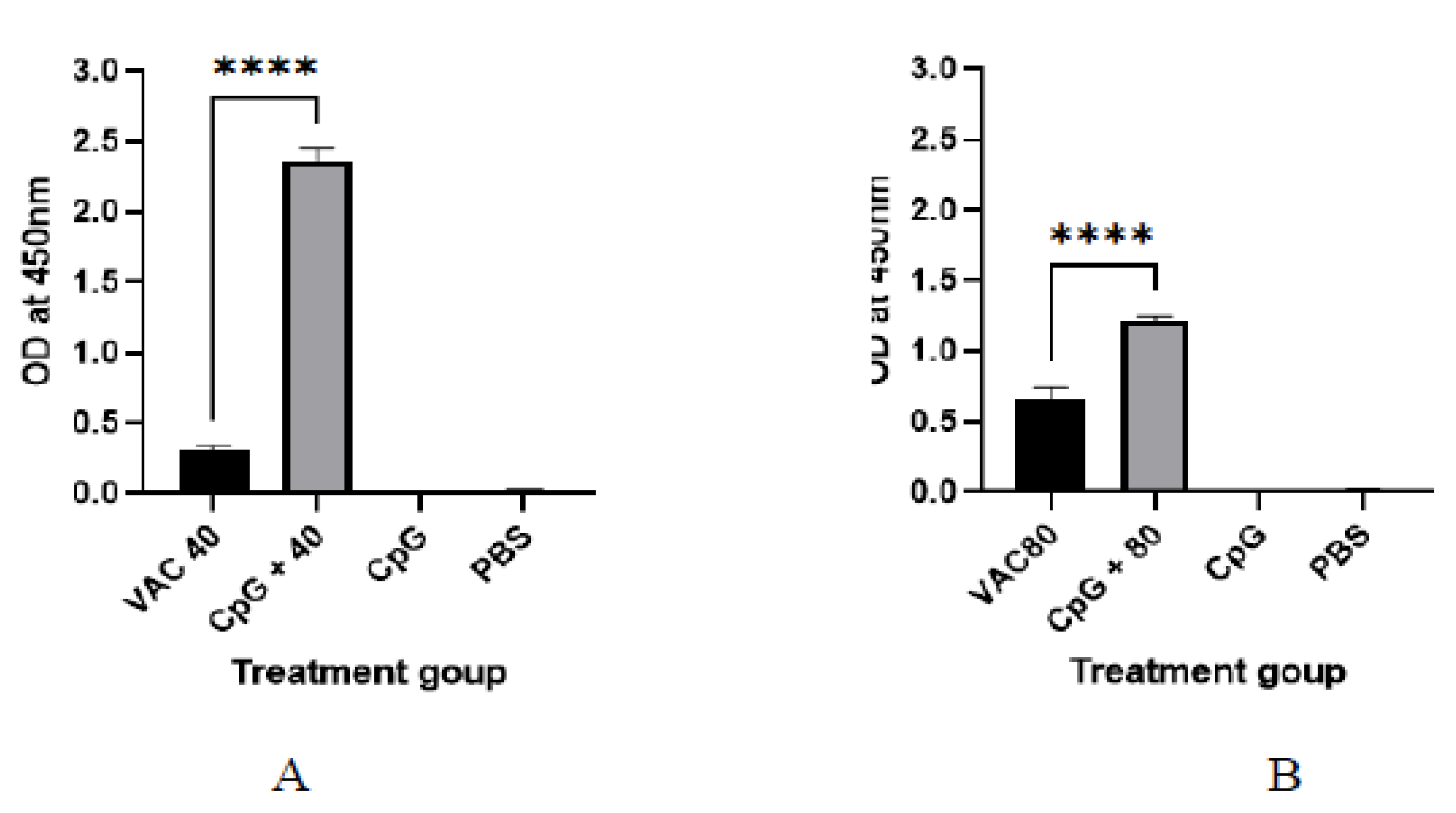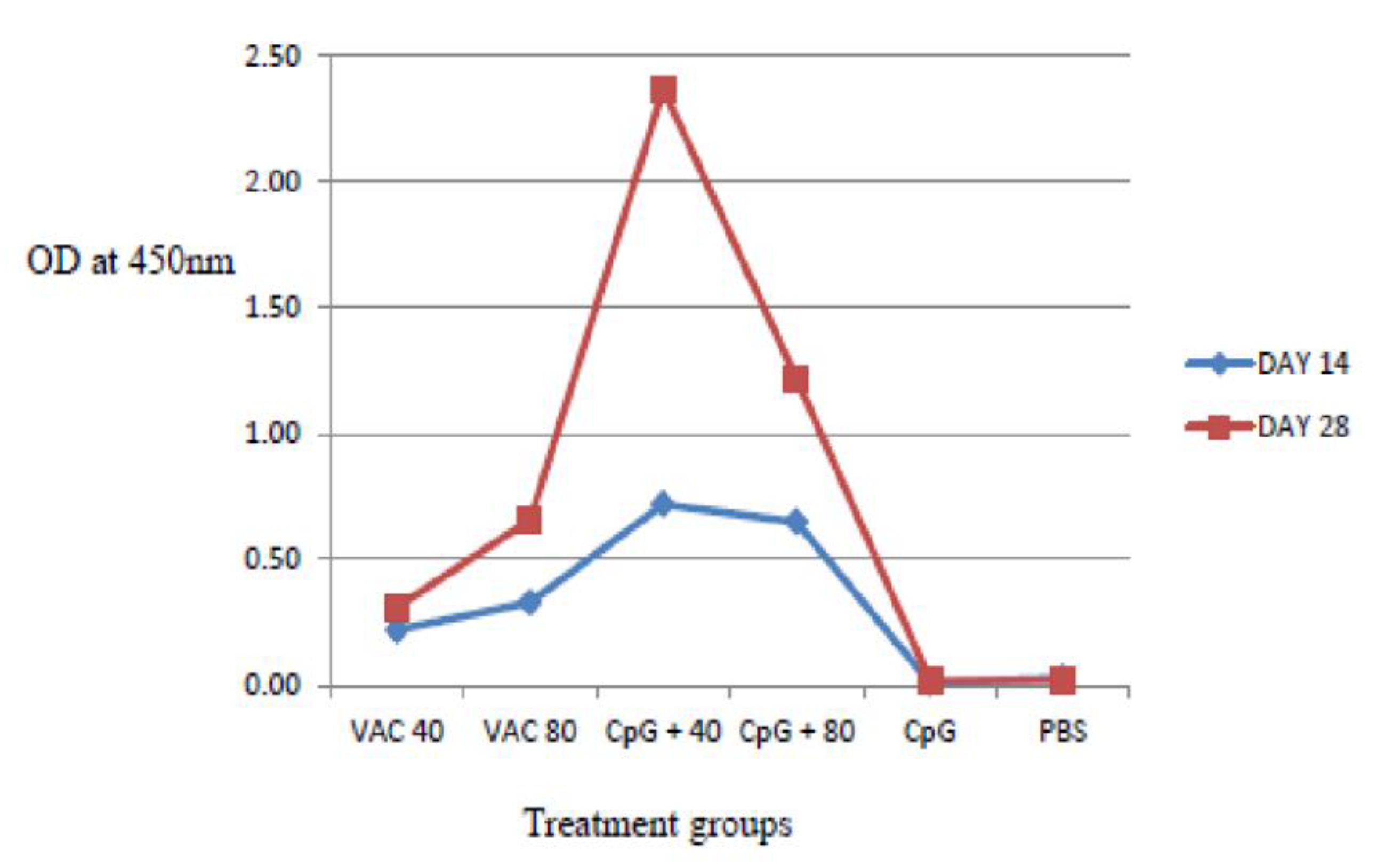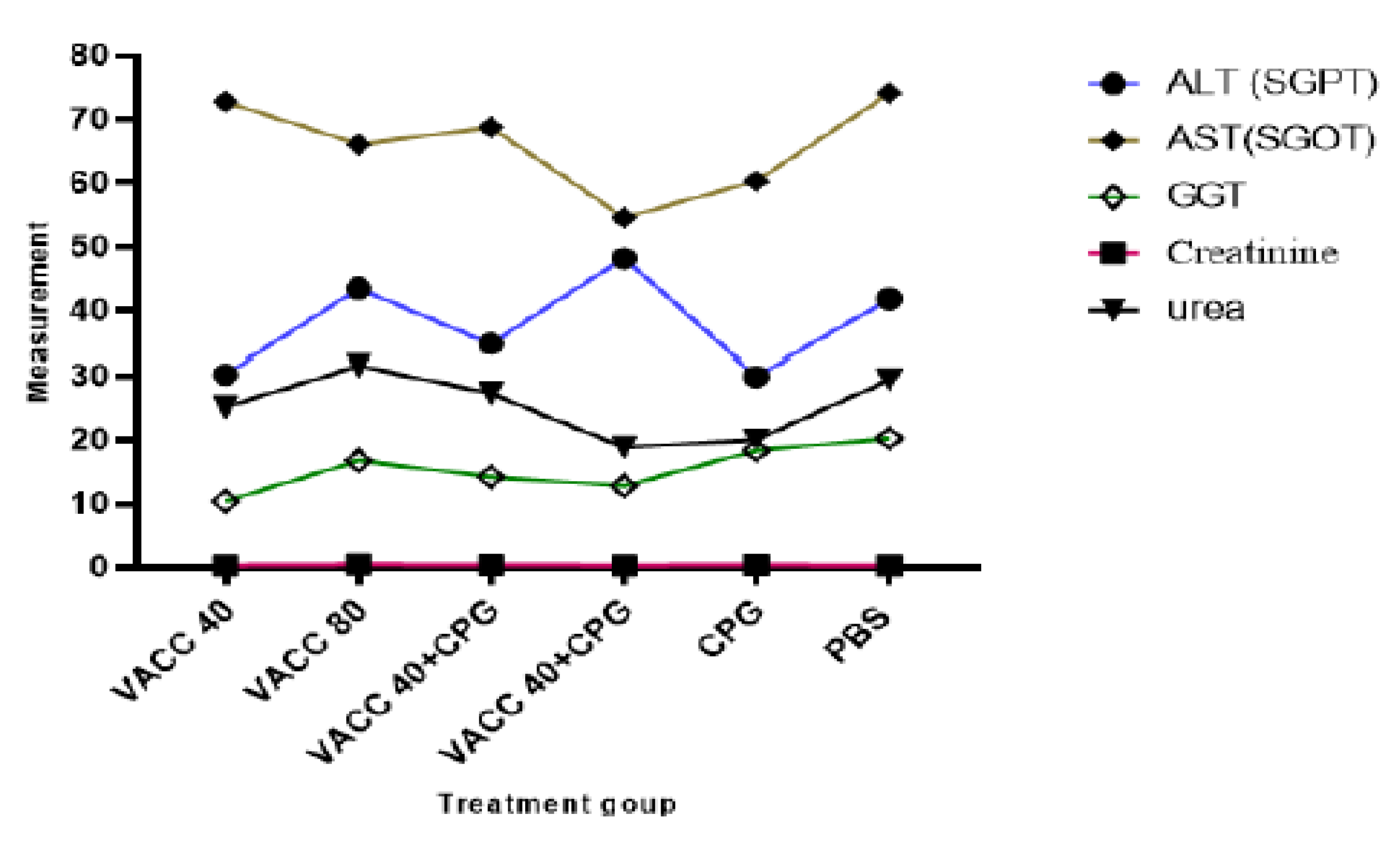Increase in the Immune Response in Balb/c Mice after the Co-Administration of a Vector-Based COVID-19 Vaccine with Cytosine Phosphoguanine Oligodeoxynucleotide
Abstract
1. Introduction
2. Materials and Methods
2.1. Study Approval
2.2. Animal Model, Sample Stratification, and Immunization
2.3. Sample Collection
2.4. Evaluation of Humoral Immune Responses to the Vaccine
2.5. mRNA Expression of TNF and INF-γ on Immunized Mice
2.6. Quantitative Polymerase Chain Reaction (qPCR)
2.7. Assessment of Hematological Profiles and Biochemical Tests
2.8. Data Analysis
3. Results
3.1. Determination of IgG Antibodies
3.1.1. Reliability Testing for the Results Obtained
3.1.2. Levels of IgG Generated within Different Experimental Groups
3.2. Evaluation of mRNA Expression on Immunized Mice
3.3. Evaluation of Hematology and Biochemical Parameters
4. Discussion
5. Conclusions
Author Contributions
Funding
Institutional Review Board Statement
Informed Consent Statement
Data Availability Statement
Acknowledgments
Conflicts of Interest
References
- Zhou, P.; Yang, X.-L.; Wang, X.-G.; Hu, B.; Zhang, L.; Zhang, W.; Si, H.-R.; Zhu, Y.; Li, B.; Huang, C.-L.; et al. A pneumonia outbreak associated with a new coronavirus of probable bat origin. Nature 2020, 579, 270–273. [Google Scholar] [CrossRef] [PubMed]
- Attia, Y.A.; Rahman, T.; Hossain, J.; Basiouni, S.; Khafaga, A.F.; Shehata, A.A.; Hafez, H.M. Poultry Production and Sustainability in Developing Countries under the COVID-19 Crisis: Lessons Learned. Animals 2022, 12, 644. [Google Scholar] [CrossRef]
- Frederiksen, L.S.F.; Zhang, Y.; Foged, C.; Thakur, A. The Long Road toward COVID-19 Herd Immunity: Vaccine Platform Technologies and Mass Immunization Strategies. Front. Immunol. 2020, 11, 1817. [Google Scholar] [CrossRef] [PubMed]
- Silva, A.C.; Moreira, J.N.; Lobo, J.M.S. Current Applications of Pharmaceutical Biotechnology; Springer: Berlin/Heidelberg, Germany, 2020. [Google Scholar]
- Shehata, A.A.; Parvin, R.; Nagy, A.; Wang, Y.; Azhar, T.M.; Attia, Y.A.; Azhar, E.I.; Paul, A.K.; Rahmatullah, M. An overview of the ongoing challenges in SARS-CoV-2 global control. Ger. J. Microbiol. 2021, 1, 1–18. [Google Scholar] [CrossRef]
- Rahman, T.; Islam, S.; Shehata, A.A.; Basiouni, S.; Hafez, H.M.; Azhar, E.I.; Khafaga, A.F.; Bovera, F.; Attia, Y.A. Influence of COVID-19 on the sustainability of livestock performance and welfare on a global scale. Trop. Anim. Health Prod. 2022, 54, 1–10. [Google Scholar] [CrossRef]
- Ndwandwe, D.; Wiysonge, C.S. COVID-19 vaccines. Curr. Opin. Immunol. 2021, 71, 111–116. [Google Scholar] [CrossRef]
- Collignon, C.; Bol, V.; Chalon, A.; Surendran, N.; Morel, S.; van den Berg, R.A.; Capone, S.; Bechtold, V.; Temmerman, S.T. Innate Immune Responses to Chimpanzee Adenovirus Vector 155 Vaccination in Mice and Monkeys. Front. Immunol. 2020, 11, 579872. [Google Scholar] [CrossRef]
- Gyebi, G.A.; Adegunloye, A.P.; Ibrahim, I.M.; Ogunyemi, O.M.; Afolabi, S.O.; Ogunro, O.B. Prevention of SARS-CoV-2 cell entry: Insight from in silico interaction of drug-like alkaloids with spike glycoprotein, human ACE2, and TMPRSS2. J. Biomol. Struct. Dyn. 2020, 40, 2121–2145. [Google Scholar] [CrossRef]
- Shang, J.; Wan, Y.; Luo, C.; Ye, G.; Geng, Q.; Auerbach, A.; Li, F. Cell entry mechanisms of SARS-CoV-2. Proc. Natl. Acad. Sci. USA 2020, 117, 11727–11734. [Google Scholar] [CrossRef]
- Shrestha, L.B.; Foster, C.; Rawlinson, W.; Tedla, N.; Bull, R.A. Evolution of the SARS-CoV-2 omicron variants BA.1 to BA.5: Implications for immune escape and transmission. Rev. Med. Virol. 2022, 32, e2381. [Google Scholar] [CrossRef]
- Hackett, C.J.; Donald, A.H. (Eds.) Vaccine Adjuvants. 2006. Available online: https://link.springer.com/book/10.1007/978-1-59259-970-7 (accessed on 4 November 2022).
- DeJong, M.A.; Wolf, M.A.; Bitzer, G.J.; Hall, J.M.; Sen-Kilic, E.; Blake, J.M.; Petty, J.E.; Wong, T.Y.; Barbier, M.; Campbell, J.D.; et al. CpG 1018® adjuvant enhances Tdap immune responses against Bordetella pertussis in mice. Vaccine 2022, 40, 5229–5240. [Google Scholar] [CrossRef]
- Alignani, D.; Maletto, B.; Liscovsky, M.; Rópolo, A.; Morón, G.; Pistoresi-Palencia, M.C. Orally administered OVA/CpG-ODN induces specific mucosal and systemic immune response in young and aged mice. J. Leukoc. Biol. 2005, 77, 898–905. [Google Scholar] [CrossRef]
- Suriano, C.M.; Verpeut, J.L.; Kumar, N.; Ma, J.; Jung, C.; Boulanger, L.M. Adeno-associated virus (AAV) reduces cortical dendritic complexity in a TLR9-dependent manner. bioRxiv 2021. [Google Scholar] [CrossRef]
- Clair, J.B.S.; Detanico, T.; Aviszus, K.; Kirchenbaum, G.A.; Christie, M.; Carpenter, J.F.; Wysocki, L.J. Immunogenicity of Isogenic IgG in Aggregates and Immune Complexes. PLoS ONE 2017, 12, e0170556. [Google Scholar] [CrossRef]
- Medrano, G.; Guan, P.; Barlow-Anacker, A.J.; Gosain, A. Comprehensive selection of reference genes for quantitative RT-PCR analysis of murine extramedullary hematopoiesis during development. PLoS ONE 2017, 12, e0181881. [Google Scholar] [CrossRef]
- Odukoya, O.A.; Ajjan, R.; Lim, K.; Watson, P.F.; Weetman, A.P.; Cooke, I.D. The pattern of cytokine mRNA expression in ovarian endometriomata. Mol. Hum. Reprod. 1997, 3, 393–397. [Google Scholar] [CrossRef]
- Silva-Santana, G.; Bax, J.C.; Fernandes, D.C.S.; Bacellar, D.T.L.; Hooper, C.; Dias, A.A.S.O.; Silva, C.B.; de Souza, A.M.; Ramos, S.; Santos, R.A.; et al. Clinical hematological and biochemical parameters in Swiss, BALB/c, C57BL/6 and B6D2F1 Mus musculus. Anim. Model. Exp. Med. 2020, 3, 304–315. [Google Scholar] [CrossRef]
- Klinman, D.M.; Ylt, A.; Beaucaget, S.L.; Conover, J.; Kriegt, A.M. CpG motifs present in bacterial DNA rapidly induce lymphocytes to secrete interleukin 6, interleukin 12, and interferon y. Proc. Natl. Acad. Sci. USA 1996, 93, 2879–2883. [Google Scholar] [CrossRef]
- Kuo, T.-Y.; Lin, M.-Y.; Coffman, R.L.; Campbell, J.D.; Traquina, P.; Lin, Y.-J.; Liu, L.T.-C.; Cheng, J.; Wu, Y.-C.; Wu, C.-C.; et al. Development of CpG-adjuvanted stable prefusion SARS-CoV-2 spike antigen as a subunit vaccine against COVID-19. Sci. Rep. 2020, 10, 20085. [Google Scholar] [CrossRef]
- Kumagai, Y.; Takeuchi, O.; Akira, S. TLR9 as a key receptor for the recognition of DNA. Adv. Drug Deliv. Rev. 2008, 60, 795–804. [Google Scholar] [CrossRef]
- Jeong, S.; Choi, Y.; Kim, K. Engineering Therapeutic Strategies in Cancer Immunotherapy via Exogenous Delivery of Toll-like Receptor Agonists. Pharmaceutics 2021, 13, 1374. [Google Scholar] [CrossRef] [PubMed]
- Germolec, D.R.; Shipkowski, K.A.; Frawley, R.P. Abstract Immunotoxicity Testing Methods and Protocols; Human Press: Totowa, NJ, USA, 2018; Volume 1803, ISBN 978-1-60761-400-5. [Google Scholar]
- Liu, C.; Tang, J. Expression levels of tumor necrosis factor-α and the corresponding receptors are correlated with trauma severity. Oncol. Lett. 2014, 8, 2747–2751. [Google Scholar] [CrossRef] [PubMed]
- García-Pérez, B.E.; González-Rojas, J.A.; Salazar, M.I.; Torres-Torres, C.; Castrejón-Jiménez, N.S. Taming the Autophagy as a Strategy for Treating COVID-19. Cells 2020, 9, 2679. [Google Scholar] [CrossRef] [PubMed]
- Farhang-Sardroodi, S.; Korosec, C.S.; Gholami, S.; Craig, M.; Moyles, I.R.; Ghaemi, M.S.; Ooi, H.K.; Heffernan, J.M. Analysis of Host Immunological Response of Adenovirus-Based COVID-19 Vaccines. Vaccines 2021, 9, 861. [Google Scholar] [CrossRef] [PubMed]
- Briesemeister, D.; Sommermeyer, D.; Loddenkemper, C.; Loew, R.; Uckert, W.; Blankenstein, T.; Kammertoens, T. Tumor rejection by local interferon gamma induction in established tumors is associated with blood vessel destruction and necrosis. Int. J. Cancer 2010, 128, 371–378. [Google Scholar] [CrossRef] [PubMed]
- Lees, J.R. Interferon Gamma in Autoimmunity: A Complicated Player on a Complex Stage; Department of Medicine, Uniformed Services University of the Health Sciences: Bethesda, MD, USA, 2014. [Google Scholar]
- Kumar, S. Immunopharmacological evaluation of adjuvant efficacy of Monophosphoryl lipid-A and CpG ODN with SARS-CoV-2 RBD antigen. bioRxiv 2022. [Google Scholar] [CrossRef]
- Pfattheicher, S.; Petersen, M.B.; Böhm, R. Information about herd immunity through vaccination and empathy promote COVID-19 vaccination intentions. Health Psychol. 2022, 41, 85–93. [Google Scholar] [CrossRef]
- Ružić-Muslić, D.; Cekić, B.; Ćosić, I.; Pavlović, I.; Maksimović, N.; Petrović, V.C.; Bijelić, Z. Hematological and Biochemical Blood Parameters of Pirot Pramenka-Endangered Sheep Population. In Proceedings of the 13th International Symposium “Modern Trends in Livestock Production”, Belgrade, Serbia, 6–8 October 2021; Available online: http://r.istocar.bg.ac.rs/handle/123456789/751 (accessed on 4 November 2022).
- Abbès, S.; Salah-Abbès, J.B.; Ouanes, Z.; Houas, Z.; Othman, O.; Bacha, H.; Abdel-Wahhab, M.A.; Oueslati, R. Preventive role of phyllosilicate clay on the Immunological and Biochemical toxicity of zearalenone in Balb/c mice. Int. Immunopharmacol. 2006, 6, 1251–1258. [Google Scholar] [CrossRef]
- Fernandes, D.P.; Pimentel, M.M.; Dos Santos, F.A.; Praxedes, A.; De Brito, P.D.; Lima, M.A.; Lelis, I.C.; De Macedo, M.F.; Bezerra, M.B. Hematological and biochemical profile of BALB/c nude and C57BL/6 SCID female mice after ovarian xenograft. An. Acad. Bras. Ciências 2018, 90, 3941–3948. [Google Scholar] [CrossRef]
- Botros, M.; Sikaris, K.A. The De Ritis Ratio: The Test of Time. Clin. Biochem. Rev. 2013, 34, 117–130. [Google Scholar]
- Marcellin, P.; Kutala, B.K. Liver diseases: A major, neglected global public health problem requiring urgent actions and large-scale screening. Liver Int. 2018, 38 (Suppl. S1), 2–6. [Google Scholar] [CrossRef] [PubMed]





| CpG ODNs | Sequences |
|---|---|
| 1828 9 (22 mer) | 5′-T*CCATGACGTTC*TACTGACGT*T- 3′ |
| 18281-1 (22 mer) | 5′-T*C*C*A*T*G*A*C*G*T*T*C*T*A*C*T*G*A*C* G*T*T- 3′ |
| 18281-2 (23 mer) | 5′-T*GA*CTGT*GAACGTTCGGATGAT*T-3′ |
| Step | Time | Temperature | Cycles |
|---|---|---|---|
| Pre-Denaturation | 10 Minutes | 95 °C | 1 |
| Denaturation | 15 Seconds | 95 °C | 45 |
| Annealing/Extension | 1 Minute | 60 °C |
| Cytokine | Forward Primer 5′--3′ | Reverse Primer 5′--3′ | NCBI | Size of Amplicon | Reference |
|---|---|---|---|---|---|
| Tumor necrosis factor (TNF) | CTCCAGGCGGTGCCTATGT | GAAGAGCGTGGTGGCCC | NM_013693.3 | 76 bp | [18] |
| Interferon Gamma (IFN-γ) | CTGATTTCAACTTCTTTGGCT | TATCCGCTACATCTGAATGA | NM_008337.4 | 136 bp | [18] |
| HPRT1 (Hypoxanthine guanine phosphoribosyl transferase 1) | TCCTCCTCAGACCGCTTTT | CCTGGTTCATCATCGCTAATC | NM_013556.2 | 90 bp | [17] |
| Compound/Molecule Dose | Optical Density (OD) Signals Generates | Coefficient of Variation % | ||
|---|---|---|---|---|
| Mouse 1 | Mouse 2 | Mouse 3 | ||
| Vac 40 | 0.239 | 0.194 | 0.234 | 11.1 |
| Vac 80 | 0.383 | 0.329 | 0.291 | 13.8 |
| Vac 40/CPG | 0.721 | 0.723 | 0.729 | 0.6 |
| Vac 80/CPG | 0.643 | 0.663 | 0.647 | 1.6 |
| CPG | 0.01 | 0.01 | 0.01 | 15.7 |
| PBS | 0.03 | 0.03 | 0.03 | 3.4 |
| Compound/Molecule Dose | Optical Density (OD) Signals Generates | Coefficient of Variation % | ||
|---|---|---|---|---|
| Mouse 1 | Mouse 2 | Mouse 3 | ||
| Vac 40 | 0.329 | 0.323 | 0.272 | 10.2 |
| Vac 80 | 0.6835 | 0.724 | 0.579 | 11.3 |
| Vac 40/CPG | 2.3095 | 2.472 | 2.322 | 3.8 |
| Vac 80/CPG | 1.251 | 1.205 | 1.2145 | 2.0 |
| CPG | 0.0175 | 0.0145 | 0.015 | 10.3 |
| PBS | 0.025 | 0.027 | 0.0205 | 13.8 |
| Parameters | Unity | VACC 40 | VACC 80 | VACC 40 + CPG | VACC 80 + CPG | CPG | PBS ** |
|---|---|---|---|---|---|---|---|
| LEUKOGRAM | |||||||
| WBC | *103/ul | 3.6 | 9.3 | 9.7 | 6.1 | 4.9 | 5.7 |
| NEUTROPHILS | % | 15.7 | 9.0 | 10.3 | 10.7 | 6.0 | 9.0 |
| LYMPHOCYTES | % | 73.7 | 84.7 | 84.0 | 84.3 | 86.7 | 85.7 |
| MONOCYTES | % | 9.3 | 5.0 | 4.7 | 5.7 | 6.0 | 6.3 |
| EOSINOPHILS | % | 1.3 | 1.3 | 1.0 | 1.3 | 1.3 | 1.7 |
| BASOPHILS | % | 0.0 | 0.0 | 0.0 | 0.0 | 0.0 | 0.0 |
| ERYTHROGRAM | |||||||
| RBC | *106/Ul | 8.4 | 9.0 | 8.7 | 8.9 | 7.9 | 7.8 |
| HB | g/dl | 16.1 | 15.8 | 15.8 | 15.5 | 13.7 | 14.7 |
| HCT | % | 40.2 | 43.2 | 42.5 | 41.8 | 37.1 | 37.3 |
| MCV | Fl | 47.9 | 42.7 | 48.9 | 46.6 | 36.7 | 48.1 |
| MCH | Pg | 19.1 | 17.6 | 18.1 | 17.3 | 17.3 | 19.0 |
| MCHC | g/dl | 39.9 | 36.8 | 37.1 | 37.1 | 36.9 | 39.3 |
| PLATELETS COUNT | |||||||
| PLATELETS | 103/ul | 130.7 | 1003.0 | 1140.7 | 1172.0 | 896.0 | 895.7 |
Disclaimer/Publisher’s Note: The statements, opinions and data contained in all publications are solely those of the individual author(s) and contributor(s) and not of MDPI and/or the editor(s). MDPI and/or the editor(s) disclaim responsibility for any injury to people or property resulting from any ideas, methods, instructions or products referred to in the content. |
© 2022 by the authors. Licensee MDPI, Basel, Switzerland. This article is an open access article distributed under the terms and conditions of the Creative Commons Attribution (CC BY) license (https://creativecommons.org/licenses/by/4.0/).
Share and Cite
Celise, D.A.; Kimotho, J.; Kimani, J.W.; Muriithi, A.K.; Odari, E.O. Increase in the Immune Response in Balb/c Mice after the Co-Administration of a Vector-Based COVID-19 Vaccine with Cytosine Phosphoguanine Oligodeoxynucleotide. Vaccines 2023, 11, 53. https://doi.org/10.3390/vaccines11010053
Celise DA, Kimotho J, Kimani JW, Muriithi AK, Odari EO. Increase in the Immune Response in Balb/c Mice after the Co-Administration of a Vector-Based COVID-19 Vaccine with Cytosine Phosphoguanine Oligodeoxynucleotide. Vaccines. 2023; 11(1):53. https://doi.org/10.3390/vaccines11010053
Chicago/Turabian StyleCelise, Divine Ainee, James Kimotho, Josephine W. Kimani, Alex Kigundu Muriithi, and Eddy Okoth Odari. 2023. "Increase in the Immune Response in Balb/c Mice after the Co-Administration of a Vector-Based COVID-19 Vaccine with Cytosine Phosphoguanine Oligodeoxynucleotide" Vaccines 11, no. 1: 53. https://doi.org/10.3390/vaccines11010053
APA StyleCelise, D. A., Kimotho, J., Kimani, J. W., Muriithi, A. K., & Odari, E. O. (2023). Increase in the Immune Response in Balb/c Mice after the Co-Administration of a Vector-Based COVID-19 Vaccine with Cytosine Phosphoguanine Oligodeoxynucleotide. Vaccines, 11(1), 53. https://doi.org/10.3390/vaccines11010053





